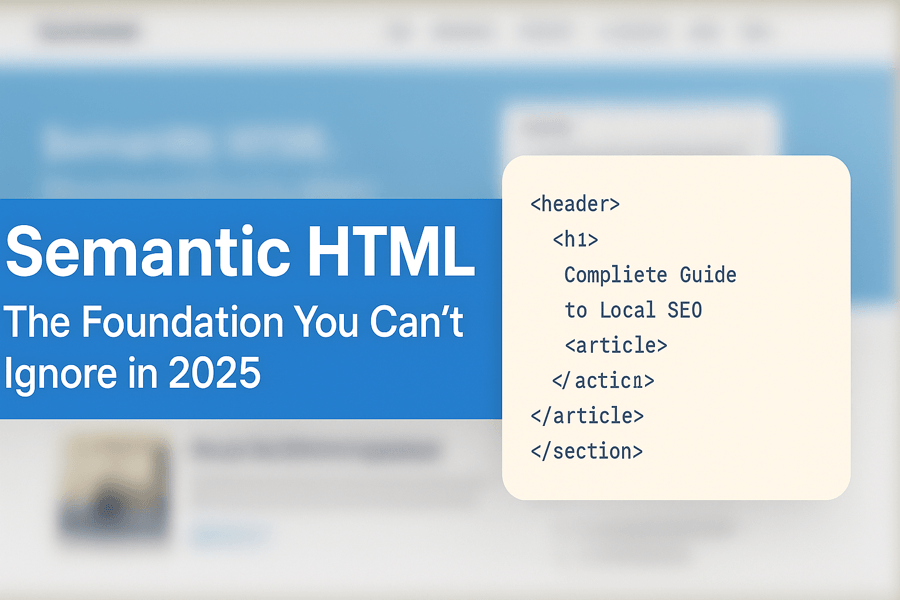Semantic HTML for SEO: The Foundation You Can’t Ignore in 2025

Last Updated on 29 July 2025 by Dorian Menard
Semantic HTML uses meaningful tags like <main>, <article>, and <section> to define content structure—not just appearance.
While not a direct ranking factor, it’s essential for modern SEO because Google’s AI algorithms rely on semantic signals to understand page content, qualify for rich results, and support topical authority. The key: semantic proximity in code matters more than visual layout for search engines.
Please do not look at our website as a reference, as it is a dog’s breakfast when it comes to code in its current state!
What Semantic HTML Actually Is (No Fluff)
Semantic HTML means using HTML tags that reflect the actual structure and meaning of your content—not just how it looks on screen. Instead of wrapping everything in generic <div> tags, you use elements that describe what the content actually is:
<!-- Non-semantic (bad) -->
<div class="header">
<div class="title">How to Build Authority</div>
<div class="date">22 July 2025</div>
</div>
<!-- Semantic (good) -->
<header>
<h1>How to Build Authority</h1>
<time datetime="2025-07-22">22 July 2025</time>
</header>
The semantic version tells browsers, screen readers, and search engines exactly what each piece of content represents. That <time> tag? Google knows it’s a date. The <header>? It’s clearly the page introduction.
Why Google Actually Cares About Semantic Structure
Here’s the reality: semantic HTML isn’t a ranking factor by itself. But it’s the foundation for everything that does matter in modern SEO.
Google’s algorithms—especially since Hummingbird, RankBrain, BERT, and now AI-powered Search Generative Experience (SGE)—rely on semantic signals to:
- Understand content hierarchy and what’s most important
- Distinguish main content from navigation, ads, or supplementary material
- Extract answers for featured snippets and AI responses
- Assess topical relevance and expertise signals
The Patent Evidence
Google’s “Page Analyzer Component” patent by Monika Henzinger reveals something crucial: semantic proximity in code matters more than visual proximity.
If two elements are visually close but semantically distant in your HTML, Google treats them as unrelated. But if elements are semantically grouped in code (even if visually separated), the algorithm understands their connection.
This is why proper semantic structure is foundational for Google’s “centerpiece annotation”—how they classify your page’s core utility and determine ranking eligibility.
The Framework That Works: Koray Tuğberk GÜBÜR’s Rules
Koray’s semantic HTML framework focuses on topical authority through clean structure. His core principles:
Structural Rules
- Use
<main>,<header>, and<footer>only once per page - Place
<h1>and summary within<header>inside<main> - Use
<section>for each major thematic group (typically around<h2>headings) - Use
<time>for all dates (with proper datetime attributes) - Keep
<aside>for non-core content like author boxes, ads, or related links
Clean Code Goals
- Stay under 900 DOM nodes for optimal crawling
- Match tags to actual function, not visual appearance
- Prioritise semantic grouping over visual layout concerns
<main>
<header>
<h1>Complete Guide to Local SEO</h1>
<p>Everything you need to dominate local search results</p>
<time datetime="2025-07-22">Published 22 July 2025</time>
</header>
<section>
<h2>Understanding Local Search Signals</h2>
<p>Content about local ranking factors...</p>
</section>
<section>
<h2>Google My Business Optimisation</h2>
<p>Content about GMB strategies...</p>
</section>
<aside>
<h3>About the Author</h3>
<p>Dorian Menard specialises in...</p>
</aside>
</main>Common Mistakes That Kill Your Semantic Structure
The <div> Disaster
Using <div> and <span> for everything creates meaningless markup. These tags carry no semantic weight—they’re invisible to search engines trying to understand your content.
Broken Heading Hierarchy
Jumping from <h1> to <h4>, or using headings for styling instead of structure, confuses both users and crawlers about your content organisation.
Mixed Content Zones
Cramming navigation, ads, and main content together without proper semantic separation makes it harder for Google to identify what matters most on your page.
How Semantic HTML Builds Topical Authority
Proper semantic structure supports topical clustering—each <section> or <article> becomes a “node” in your expertise map. When you:
- Group related concepts in semantic containers
- Link between clusters using clear anchor text
- Maintain consistent heading hierarchy across related pages
…you’re building the semantic relationships Google uses to assess expertise and authority in your field.
The AI Search Connection
As Google integrates more AI into search results, semantic HTML becomes even more critical:
- Featured snippets extract answers from semantically structured content
- SGE responses rely on clear content hierarchy to understand context
- Rich results depend on proper semantic markup for dates, authors, and structured data
Your semantic structure directly impacts your eligibility for these enhanced search features.
Real-World Implementation Checklist
Structure Audit
- One
<main>per page containing primary content -
<header>with<h1>and page summary inside<main> - Each major topic in its own
<section> - All dates marked up with
<time datetime="YYYY-MM-DD"> - Supplementary content in
<aside>elements
Content Organisation
- Logical heading hierarchy (h1 → h2 → h3, no skipping)
- Navigation clearly separated in
<nav>elements - Articles and blog posts wrapped in
<article>tags - Contact information in
<address>elements where appropriate
Technical Validation
- HTML validates without errors
- Under 900 DOM nodes for clean crawling
- Semantic meaning matches visual presentation
- Screen reader accessibility maintained
Why This Matters More Than Ever
Semantic HTML isn’t just good practice—it’s essential infrastructure for modern SEO. As search engines become more sophisticated and AI-driven, the sites that clearly communicate their structure and meaning will have distinct advantages in:
- Content understanding and relevance assessment
- Feature snippet qualification and rich result eligibility
- Topical authority recognition across content clusters
- User experience through improved accessibility
The bottom line: if you’re serious about SEO in 2025 and beyond, semantic HTML isn’t optional. It’s the foundation everything else is built on.